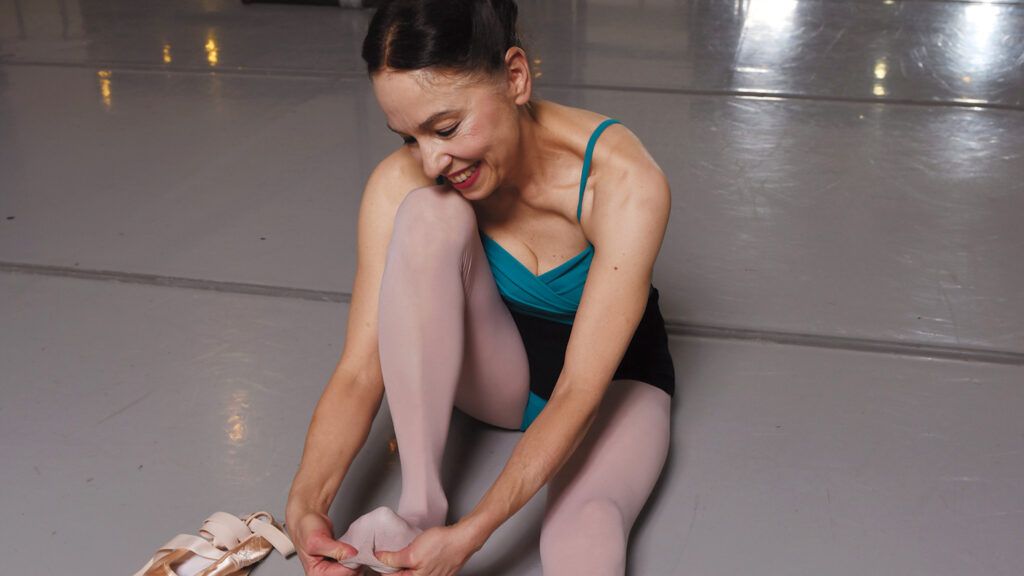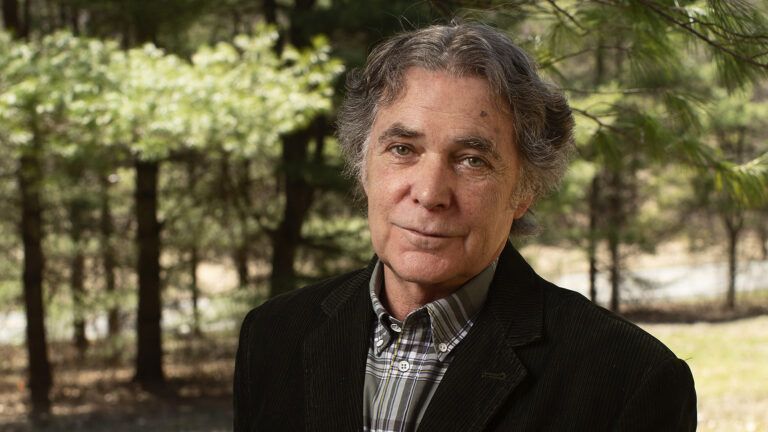Light streamed in through the windows of the yoga studio. I stood gingerly on my mat and took a deep breath, trying to keep myself centered. Focused. Calm. But I’d never been more afraid in my life. I exhaled. Pain knifed through my left leg. My hip had gone out during a performance of The Nutcracker a few weeks ago, and it wasn’t healing. Will I ever dance again? I asked.
I had been front and center in the “Waltz of the Flowers,” doing piqué turns in my hot-pink tutu, when I felt something shoot through my left hip. From that second on, every movement I made was torture. Standing en pointe, I gritted my teeth. I knew I had to carry on with the performance. But the doubts rolled in. This is what you get, I said to myself. Ballet is for young people. You’re 60 years old. Somehow I made it offstage and collapsed onto a chair, trying to breathe through the pain.
I’d been a ballerina forever. My mother signed me up for lessons here in Huntington, West Virginia, when I was five years old—a tomboy who loved football and hated tutus. I didn’t really fall in love with dance until six years later. That was when I discovered it was the closest thing to flying. I would run across the floor, leap into a grand jeté and soar through the air. Then I’d do one pirouette. Two. Three. Spinning like a top, I’d never felt so alive.
In high school, I danced with a ballet company in Huntington, working my way up to soloist. Then I moved to New York City, where I split my time between ballet and, my other love, theater. I studied at the American Ballet Theatre and at NYU’s Tisch School of the Arts, where I was taught by many of the greats. When I finished acting class with Stella Adler on 55th Street, I would walk up to 61st to take $3 dance classes at ABT with Patricia Wilde. My very first job out of school was as a dancer in the national touring company of Jesus Christ Superstar. Dancing and acting worked hand in hand.
Life in New York in the early 1970s was thrilling. But it wasn’t all footlights and standing ovations. I had the usual challenges that plague ballerinas. Cramping calves. Bleeding toes. I developed sciatica. The pain was unrelenting, chronic. But I pushed through.
As much as I loved ballet, I decided to hang up my pointe shoes when I turned 23. Most of my friends quit ballet around that time. It was a cultural thing. People didn’t realize back then that ballerinas could dance well into their twenties and beyond. I didn’t see anyone much older than me onstage. Most dancers became teachers and choreographers. I felt as if ballet was a passion for a younger person—the girl I had been. As Paul said in Corinthians, it was time to “put away childish things.” I had my acting career to consider. After all, I’d landed a recurring role on As the World Turns and was taping all the time.
Still, saying goodbye to ballet left a hole in my heart. Nothing could match the sense of exhilaration I felt when movement melded to music and I lost myself in dance.
I tried to stay active. I went to the gym. Took aerobics classes. Lifted weights. These were the early days of Jane Fonda exercise tapes; it was still unusual to see a woman sweat. But I was persistent and kept my body in shape.
After 20 years of New York City apartment living, my husband—a filmmaker and writer—and I wanted a house of our own. We moved back to my hometown of Huntington, where I joined the Y. One day, I was at the gym there, trying to stretch out some of the tightness that radiated from my hip all the way down my leg. Music was blaring. TVs droned on in front of me. Somehow through all the noise, I heard a whisper: “I made you for other things, Deborah.”
I knew it was the voice of God. What does he mean? I thought.
I looked at the Nautilus machines. An idea formed in my mind. An image of the girl I had once been—joyful, leaping, turning. A ballerina. The gym around me fell away, and I was in a studio again. I went to one of the machines and used it as a ballet barre, holding on with one hand, raising and unfolding one leg in a developpé. Then I let go of the barre and…balanced! Was my developpé perfect? Far from it. But my extension was full and my placement firm. I was 48. After all these years, I could still dance!
I knew that returning to ballet wouldn’t be easy. I didn’t even have dance shoes and clothes anymore. I ordered tights and pointe shoes through a discount catalog. I didn’t realize until the shoes arrived that they were made of flexible plastic—with gel padding! So comfortable. Like sneakers. No break-in time necessary. Just right up en pointe. And the tights were compression. So much easier for extensions. And perfect for older ballerinas. Maybe I could do this after all.
I started taking classes in Huntington. My classmates were high school and middle school students. They were delightful. I thought of myself as I had been at that age, so full of wonder and ambition. The teacher was in her seventies. If I ever tried to make the excuse “I can’t do this. I’m too old,” she would just give me a look. As if to say, Try me, Deborah. Watching her dance reminded me that age was no barrier to ballet.
When that teacher got sick and briefly had to close her studio, I moved to classes at the Charleston Ballet. The next oldest student there was 25, but that didn’t bother me. I danced my heart out. Jumping, leaping and spinning. This was what God made me for!
One day the artistic director took me aside. “Would you like to dance with our company?”
“Absolutely!” I said. I loved to dance for myself, but I was thrilled to think that I could perform ballet again.
Of course the pain was still there. But whenever I suffered aches, I remembered another artist who’d pushed through chronic pain. French Impressionist painter Pierre-Auguste Renoir had been confined to his home during his later years, nearly paralyzed by rheumatoid arthritis. Yet he’d kept painting. Fluid brushstrokes, vivid colors. He’d captured Mediterranean landscapes, the drama of classical mythology, wistful bathers. A true master. Painter Henri Matisse, 28 years his junior, often came to visit him.
“Why do you continue to paint when you are in such agony?” Matisse is said to have asked him.
Renoir replied, “The pain passes, but the beauty remains.” These words became my mantra. When my sciatica flared up, I coaxed my spine back into alignment by rocking on a foam roller. I found a good physical therapist and did the stretching and strengthening exercises she recommended. I practiced yoga breathing to calm my mind and nervous system and to focus on something beyond the pain. I repeated to myself, “The pain passes, but the beauty remains.”
Then my hip had given out during The Nutcracker. Afterward nothing helped—not foam rolling, not stretching, not yoga breathing.
Here I was in the yoga studio, my left side throbbing, unable to focus on anything but the pain. I collapsed onto the mat, closed my eyes and surrendered. If you want me to stop dancing, God, make it very clear to me. I promise I’ll do what you want.
Almost immediately, I heard a thunderous voice. “Dance!” My eyes sprang open. There was no doubt about the path God saw for me. I knew what I had to do.
Soon after, a friend put me in touch with an orthopedic specialist in Columbus, Ohio. He worked with athletes and was known for fast recoveries. I went to see him. After looking at my X-rays, the doctor said that I had been dancing with no cartilage whatsoever in my hip, just bone on bone. No wonder I was in such pain.
“You need a hip replacement,” he told me. A hip replacement? Could I really dance again after major surgery? I wondered, then caught myself. God had spoken. I would set my concerns aside and put my trust in him.
But lying in my hospital bed after the surgery, I felt the doubts return. What did I let them do? What if my body’s never the same?
A chipper nurse came into my room and said, “We’re going to walk now.”
I had been awake only an hour. “Oh, no, we’re not.”
He insisted on rolling me out of bed and helping me stand, supported by a walker. “Now take a step.”
“I can’t.”
“Just one. I’m right here with you.”
I took a step. Oh my goodness! I was shocked. There was no pain. You can walk again, Deb! I felt elated. Invigorated. I looked at the metal frame of the walker. Just as I had at the gym all those years ago, I felt the hospital drop away. I was in a ballet studio again. I envisioned the walker as a barre. Carefully I lifted my leg to touch it. The range of motion in my new hip was incredible.
The nurse nearly fell down laughing. “You’re going to be fine.”
Thank you, Lord, for making my path clear. In that moment I knew that I would return to ballet. And just four months later, after a smooth rehabilitation period, I found myself dancing in Swan Lake, twirling in the swan corps and the whimsical Hungarian czardas. The pain has passed, but the beauty remains.
Read more: Deborah Novak’s Tips on Coping with Pain
For more inspiring stories, subscribe to Guideposts magazine.





